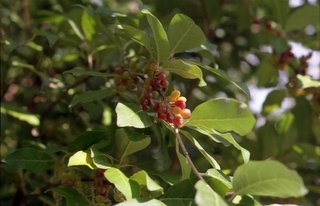
I have a little patch of cleared, level ground surrounded by trees and brush here on Droop Mountain, and much of the brush consists of this pretty plant, Elaeagnus umbellata, autumn olive. The USDA now classifies Elaeagnus umbellata as a noxious weed for the state of West Virginia, but in the 1970's in Pocahontas and Greenbrier counties, their Soil Conservation agency planted it as part of strip mine reclamation. It is invasive, it is hard to kill, but it has these really pretty, red berries, fragrant white flowers, and silvery leaves, and there is an indigo bunting that sits and sings for many hours each spring in one of these bushes.
I also remember it fondly from a graduate course in plant taxonomy, because the family is easy to identify by its elaeagnaceous hairs. They are much too small for my macro lens (I have the extension rings, but I'm too lazy and out of practice to work out a flash setup.) The photo I've linked to, from the Digital Flora of Texas Vascular Plant Image Library's Elaeagnaceae Page, hints at these scale-like hairs but does not do them justice. Take a strong hand lens and outdoor light, and have a look at any plant part this spring. Foliage, flowers, new twigs, fruits--all are covered with elegant, silvery elaeagnaceous hairs.
Until I started writing this entry, I was misidentifying the shrubs as Elaeagnus angustifolia, Russian olive. As "angustifolia" indicates, the leaves of Russian olive are more lanceolate than those of autumn olive. (Botanists use such poetic language. I would never otherwise have occasion to say "lanceolate.") According to the USDA Natural Resources Conservation service, Russian olive is not found in West Virginia, although it is recorded in all surrounding states. Sounds like a challenge, doesn't it?
No comments:
Post a Comment